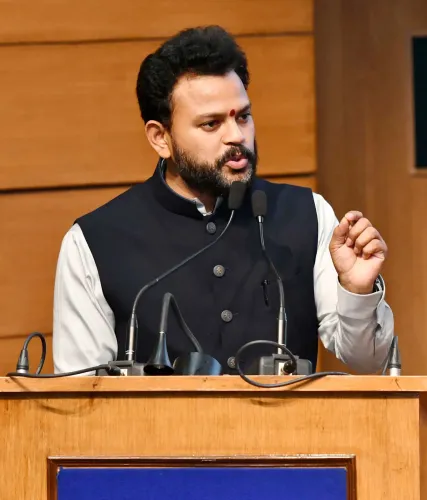Has India’s Defence Budget Really Doubled in Just 11 Years?

Synopsis
Key Takeaways
- India's defence budget has witnessed a 2.6 times increase.
- Operation Sindoor showcased the effectiveness of indigenous technology.
- Public-private collaboration has driven significant advancements.
- Self-reliance in defence technology is a top priority.
- India is emerging as a trusted global defence exporter.
New Delhi, May 13 (NationPress) India’s annual defence budget has surged 2.6 times, rising from Rs 2.53 lakh crore in 2013-14 to Rs 6.81 lakh crore in 2025-26. This substantial increase underscores India’s unwavering commitment to enhancing national security, modernising its armed forces, and fortifying military infrastructure, as outlined in a statement from the Ministry of Defence.
The statement further elaborated that strategic reforms, along with private sector involvement and innovation, have significantly propelled indigenous manufacturing. This shift has not only made India self-reliant but has also established it as a globally trusted defence exporter, ultimately contributing to national security and economic advancement.
The partnership between the government and private sector in India’s defence landscape has catalyzed progress in various domains, including arms and ammunition, aerospace, electronics, and naval technologies. Supported by initiatives like ‘Make in India’ and relaxed FDI regulations, this collaboration has strengthened domestic production capabilities and attracted global investments in defence innovation, leading to a remarkable increase in military equipment exports.
During a recent address, Prime Minister Narendra Modi asserted that the capabilities of Made in India defence equipment were convincingly demonstrated during Operation Sindoor against Pakistan, where precise strikes dismantled terrorist infrastructures and inflicted substantial damage on enemy airbases.
“The world is now recognising the emergence of Made in India defence systems as a formidable force in contemporary warfare,” PM Modi remarked.
He elaborated on how this operation revealed Pakistan’s weaknesses, as their drones and missiles disintegrated against India’s advanced air defence systems, which effectively neutralised them in mid-air.
PM Modi also highlighted how Indian drones and missiles executed remarkably accurate strikes, inflicting significant damage on Pakistani airbases that had long been touted as invulnerable. Within just three days of India's response, Pakistan experienced destruction that exceeded its anticipations. Consequently, Pakistan sought ways to de-escalate, appealing to the international community for intervention amidst rising tensions.
Operation Sindoor has introduced a new facet to India’s military capabilities, showcasing the nation's exceptional proficiency in both desert and mountainous warfare, while affirming dominance in New Age Warfare.
Prime Minister Modi referenced the Indian-made BrahMos missiles that targeted airbases and air defence mechanisms deep within Pakistan. The robust air defence ecosystem developed over the past 11 years effectively countered a barrage of drone and missile threats from Pakistan. The operation demonstrated the smooth integration of vital defence assets such as the Integrated Counter-Unmanned Aerial System (UAS) Grid, S-400 Triumph systems, Barak-8 missiles, Akash Surface-to-Air Missiles, and DRDO’s anti-drone technologies.
Notably, a significant achievement in India’s defence sector was the successful deployment of Kamikaze drones, co-developed by the Adani Group’s Alpha Design Technologies and Israel’s Elbit Systems, during Operation Sindoor.
Manufactured in Bengaluru under the ‘Make in India’ initiative, the SkyStriker drones are capable of executing precision strikes with a loitering duration of up to 2 hours. This advancement represents a significant leap towards India's self-sufficiency in cutting-edge defence technology.








